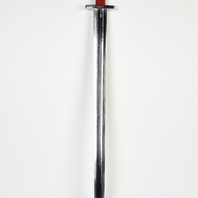
Viking Objects
Reproduction Viking Age Sword
A reproduction of the sword found in Grave 511 at Repton. The hilt is made of wood laths wrapped in tabby weave textile strips. The scabbard is made of two wooden laths, lined with trimmed sheep fleece, and covered in an oak-stained, stitched, calf-leather cover. The strap slide is copper alloy and inserted under the leather. The sword belt shown with the scabbard is based on the sword belt from Grave 511 at Repton.
Read More
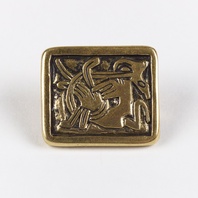
Viking Objects
Reproduction Square Mammen Brooch
This reproduction brooch is based on a small number of Mammen-style brooches found in England. Three rectangular brooches of this type are known from Linwood, Lincolnshire, West Stow Heath, Suffolk, and Bergh Apton, Norfolk, with further examples found in Cambridgeshire and East Anglia in 2015 and 2016. It is a type which has Carolingian-inspired shapes and Scandinavian decoration, which seem to have been produced in the Danelaw, and was an accessory for women who wore Scandinavian dress. Scandinavian brooches came in a variety of sizes and shapes which included disc, trefoil, lozenge, equal-armed, and oval shapes. The different brooch types served a variety of functions in Scandinavian female dress with oval brooches typically being used as shoulder clasps for apron-type dresses and the rest being used to secure an outer garment to an inner shift. Anglo-Saxon brooches do not match this diversity of form with large disc brooches being typical of ninth century dress styles with smaller ones becoming more popular in the later ninth and tenth centuries. However, since disc brooches were used by both Anglo-Saxon and Scandinavian women they are distinguished by their morphology. Scandinavian brooches were typically domed with a hollow back while Anglo-Saxon brooches were usually flat. Moreover, Anglo-Saxon brooches were worn singly without accompanying accessories.
Read More
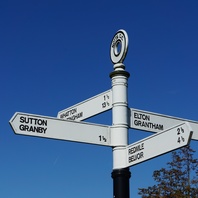
Viking Names
Granby
Granby, in the Bingham Wapentake of Nottinghamshire, comes from the Old Norse male personal name Gráni and the Old Norse element by ‘farmstead, village’. It is of interest that a document from c. 1200 records that there was a Granehou nearby and it is possible that this was the burial-mound (Old Norse haugr) of the same Gráni who gave his name to the village. Unfortunately, no such mound can be identified today.
Read More
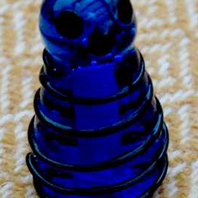
Viking Objects
Reproduction Glass Kingpiece
This glass kingpiece is a reproduction based on a set found in grave 750 at the Viking Age settlement of Birka, Sweden. This piece would have been used to play hnefatafl, a board game which is known to have been played in Scandinavia in the Viking Age.
Read More
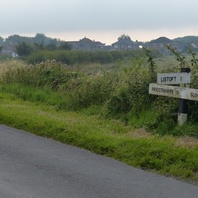
Viking Names
Sloothby
Sloothby, in the Calcewath Wapentake of Lincolnshire, is a complicated name. There are multiple possibilities for the first element of the place-name. The second element is the Old Norse element by ‘a farmstead, a village’. One suggestion is that the first element is the Old Norse byname Slóði ‘the lazy one’; however, this name is not found independently in Lincolnshire and is uncommon in Scandinavia. Another alternative is that the first element could be slóði used as a river-name, referring to a slow-moving sluggish stream. Sloothby is in the fens and a stream runs by. Furthermore, the first element could be the Old Norse element slóð ‘a track, trail’, perhaps referring to a track through the fens. Sloothby is a joint parish with Willoughby.
Read More
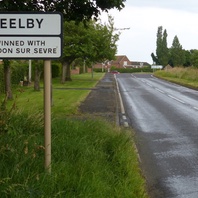
Viking Names
Keelby
Keelby, in the Yarborough Wapentake of Lincolnshire, is a Old Norse compound coming from kjǫlr ‘a keel, a ridge (of hills)’ and by ‘farmstead, village’. The village is situated on a rising piece of ground between 15 and 20 metre contours (one small patch above 20 metres). This forms a distinct elongated ‘ridge’ running south-east-north-west.
Read More
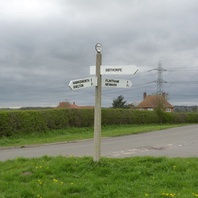
Viking Names
Sibthorpe
Sibthorpe, in the Newark Wapentake of Nottinghamshire, comes from either the Old English male personal name Sibba or the Old Norse male personal name Sibbi and Old Norse þorp ‘a secondary settlement, a dependent outlying farmstead or hamlet’.
Read More
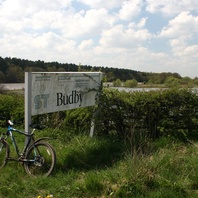
Viking Names
Budby
Budby, in the Bassetlaw Wapentake of Nottinghamshire, likely comes from the Old Norse male personal name Butti (or possibly Botti)and the Old Norse element bý ‘farm, settlement’. Budby is a joint parish with Perlethorpe.
Read More
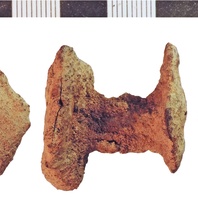
Viking Objects
Clench Nail (NLM-2FC690)
Clench nails were used in clinker-style ship-building from the 7th century to the 15th and also for domestic purposes, in which clench nails might appear where ship timber has been reused. Clinker ship-building involved building the ship’s hull first out of layered planks attached to the keel and held together using clench nails. Clinker-built boats and ships are particularly associated with the Vikings.
Read More
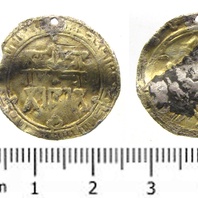
Viking Objects
Samanid Silver Dirham Pendant (LCNCC:2014.16)
An Arabic silver dirham minted c. 905-906 (Hijra 293) for the Samanid ruler, Isma’il ibn Ahmad (849-907), that has subsequently been pierced and gilded so that it could be worn as a pendant. It was probably minted in Balkh, Afghanistan. The Vikings often repurposed items like this. The dirham was a unit of weight used across North Africa, the Middle East, and Persia, with varying values which also referred to the type of coins used in the Middle East during the Viking Age. These coins were extremely prized possessions not only for their silver value but as a way of displaying one’s wealth and vast trade connections. Millions of Arabic dirhams would have been imported throughout the Viking world and are mostly found in hoards.
Read More
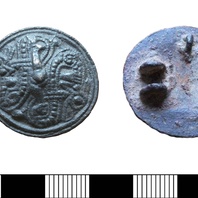
Viking Objects
Jellinge-Style Disc Brooch (LIN-F00E1B)
This Viking cast copper-alloy disc brooch is decorated with a Jellinge-style moulded zoomorphic motif comprising a knot of beaded lines. Brooches of this type are widespread in Scandinavia, with a particular concentration at Birka, the trading and military site in Sweden. For more information on Scandinavian jewellery in England check out our blog: Brooches, Pendants and Pins: Scandinavian Dress Accessories in England.
